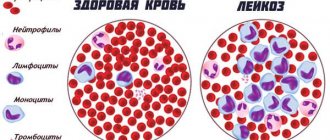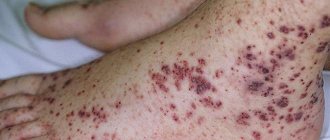729
0
One of the most common oncopathologies of early childhood is blood leukemia in children. According to statistics, its share is about 30% of the total number of cancers that appeared in childhood.
The same medical statistics claim that for every 100 thousand children, 3-5 people develop blood cancer. Most often, lesions of the hematopoietic system are detected in patients aged 2 to 5 years. There is also a congenital form of leukemia, when abnormalities are detected immediately or a short time after the birth of the child.
Since in the case of childhood leukemia there is no need to talk about the long-term pathogenic influence of the environment, bad habits, prolonged use of medications and poor lifestyle, the most likely cause of the disease is genetic abnormalities at the cellular level.
Also, the prerequisites for the development of blood cancer in childhood include radioactive and ultraviolet irradiation of a woman during pregnancy, viral diseases she has suffered and congenital genetic pathologies of the child (Down syndrome, neurofibromatosis, Fanconi anemia, others).
Characteristics of the disease in children
Leukemia, or leukemia, in children is a malignant blood disease that causes a failure in cell formation. The embryonic cell does not go through the entire development cycle and remains in the blast stage. Healthy white blood cells are replaced by atypical pathogens during the process of division. The blast layer gradually completely replaces the normal leukocyte row.
The replacement of healthy cells by abnormal cells is called leukemia. When a tumor forms in a certain area, it begins to actively grow. The disease has a pronounced malignant nature. The tumor process is characterized by rapid spread throughout the body through the bloodstream. Tissue metastasis occurs quickly, especially in children.
The use of special medications and other therapeutic techniques will help stop the proliferation of cancer cells. It is impossible to stop the anomalous process on your own.
Childhood leukemia is aggressive in nature. Metastases spread through the blood very quickly, affecting tissues, and secondary foci and pathologies arise. Treatment of leukemia at an early stage always ends positively. At later stages of development, the disease can also be cured, but the process is delayed. The child tolerates treatment procedures more easily and follows the doctor’s clinical recommendations unquestioningly, which significantly increases the chance of recovery.
Children from 2 to 5 years old suffer from leukemia more often. But there are examples in medical practice of the disease occurring in infants under one year of age and in adolescents. Basically, acute leukemia with rapidly manifesting symptoms is diagnosed. Pediatrics is looking for options to prevent childhood incidence of blood cancer and early detection of the disease.
How does the disease manifest itself?
Symptoms of leukemia in children and adults, as mentioned above, depend on the form of the disease, but they still have something in common:
- lymph nodes enlarge;
- body temperature periodically rises for no reason;
- if tissue is damaged, there may be increased bleeding;
- constant weakness;
- pain in the liver area;
- always want to sleep;
- shortness of breath and sweating;
- loss of appetite;
- weight loss;
- joint pain;
- susceptibility to infections.
Causes of disease development in children
Doctors associate the risk of the disease in childhood with a cellular mutation of the leukocyte lineage. Along with this, the following reasons are identified that provoke the development of pathology:
- Hereditary predisposition.
- Etiology of exposure to radiation.
- The presence of a virus that can cause cancer.
- Taking specific medications.
- Endogenous disorder in the chromosomal sequence of cells - Down syndrome, Li-Fraumeni syndrome and others.
- Radiation therapy and chemotherapy prescribed to treat cancer of another organ can cause leukemia.
- Lack of plant fiber in the child’s diet.
- Exposure to toxic and carcinogenic substances.
- Living in an unfavorable ecological area.
The disease can be provoked by any factor or a combination of several at the same time.
General description of leukemia
Leukemia progresses in the case of an accumulation of concentrations of immature cells directly in the bone marrow, uncontrollable by the human body, leukemia affects the body.
Consequently, the bone marrow, instead of producing young cells, forms unnecessary ones, which are released into the blood . As a result, I diagnose malignant tumors.
Blood in leukemia
What cells are formed in leukemia?
The formed white cell will not perform the functions necessary for the body, but at the same time actively multiplies.
Childhood leukemia has two forms that differ from each other:
- Lymphoblastic leukemia. With the development of this type of pathology in childhood, cells of immature lymphocytes are predominant,
- Myeloid leukemia. The development of the disease progresses with the help of myeloblasts, monoblasts, erythroblasts and megakaryoblasts.
What causes leukemia in children?
Factors influencing the formation of this disease are not clearly defined. Doctors rely only on theoretical data and practical cases that have already happened before.
Due to the fact that in childhood risk factors that appear in adulthood are rarely affected, a possible cause is also sought in genetic diseases or genetic mutations.
Possible factors include:
- Effect of radiation exposure. Cell mutation is caused by direct radioactive radiation. Children living in areas close to radiation sites suffer the most. Also, if a woman carrying a child was in an area with radiation emissions, then the chance of being affected by lymphoblastic and myeloid leukemia increases by 5 and 20 times, respectively.
- Radiation therapy. Under the influence of this course of treatment, with the parallel use of cytostatics for the treatment of tumors of various types, can lead to myeloid blood cancer in the next 10 years,
- Solar radiation. The release of environmental pollution and space flights leads to the destruction of the Earth's ozone layer. As a result, radiation has an increasingly harmful effect on humans, progressing for the worse every year,
- Medications. There is a risk of developing lymphoblastic leukemia in children who are given immune-suppressing medications after an organ transplant because the body may reject the new organs.
- Viruses. The effect of viruses on cells is manifested in changes in DNA. Infection of the bone marrow virus will lead to failure of cell formation. This leads to the formation of tumor processes in childhood,
- Hereditary diseases. The likelihood of the disease was found in patients with: Down syndrome, with this pathology the chance of the disease increases 15 times, Klinefelter syndrome, Franconi anemia, neurofibromatosis, and other diseases,
- Ecology. Man directly influences the ecology of his environment. All emissions of substances into rivers, seas, oceans and the atmosphere lead to contamination of the environment, food and drinking water. Then all this enters our body with food and water, saturating the body with harmful substances, which contribute to the formation of tumor formations.
- Risk during pregnancy. Bad habits during pregnancy contribute to myeloid leukemia in the fetus. Also, factors affecting the fetus during gestation include long exposure to the sun and ingestion of poisons (arsenic, gasoline, lead, etc.),
- Bad habits. Parental smoking can directly affect the development of leukemia in a child. When inhaling cigarette smoke, the child’s body does not filter it and delivers it directly into the blood.
The risk of damage in children of twins has been studied:
- The risk of pathology for the second if one child is affected is 25% (in the case of identical twins),
- The risk of lesions in non-identical couples is 2-4 times increased.
The listed reasons are the reasons for the formation of malignant tumors in children. Since the child’s body and immunity are poorly protected from the effects of negative factors.
Classification of the disease
The classification of the disease depends on the time of the oncological process, the cellular composition of the tumor and structural characteristics.
According to the speed of development of the pathology, two types are distinguished - acute leukemia (develops up to 2 years) and chronic type (development of the disease over 2 years). Sometimes doctors use another term in medical practice – congenital leukemia.
The acute form of leukemia is divided according to the structural characteristics into lymphoblastic and non-lymphoblastic types. Lymphoblastic cancer is characterized by rapid division of abnormal lymphocytes. There are three types of disease:
- With small lymphoblasts (L1);
- Containing large polymorphic lymphoblasts (L2);
- With large polymorphic lymphoblasts capable of separating the cytoplasm within the cell body (L3).
Depending on the presence of antigenic markers, there are such types - O-cell, T-cell and B-cell. In children, the O-cell type of leukemia with L1 type cells is more often diagnosed - up to 80% of all cases.
Non-lymphoblastic leukemia has several types of cells. The following types are distinguished in this group:
- Myeloblastic poorly differentiated (M1), undifferentiated (M0) and highly differentiated (M2) types.
- Promyelocytic type (M3).
- Myelomonoblastic (M4) and monoblastic (M5) leukemia.
- Erythromyelosis (M6).
- Megakaryocytic (M7) leukemia.
- Eosinophilic (M8) form.
Scientists identify two more forms of leukemia:
- Lymphocytic leukemia is characterized by active proliferation of lymphocytes.
- The myeloid form is characterized by active division of granulocytes.
Acute biphenotypic leukemia differs from others in the presence of markers characteristic of the lymphoid and myeloid forms.
Cancerous leukocytes under a microscope
The clinical development of the disease goes through certain stages of development:
- The first stage is considered the acute phase, defined by the expression of signs of the disease before the onset of symptoms of improvement after courses of therapy.
- The second stage determines the presence of partial or complete remission of the treatment of the disease.
- The third stage is the relapse stage.
How is leukemia classified?
Classification of leukemia also implies its division into forms, stages and types.
Blood cancer exists in two types:
- Lymphoblastic leukemia. It mainly makes itself felt in children from the first year of birth. A malignant tumor develops from lymphoblasts. The tumor originates directly in the bone marrow; as the disease progresses, it progresses to the lymph nodes, nervous system and spleen.
- Myeloid leukemia. This diagnosis is also called non-lymphoblastic. In many cases it affects female and male children aged 2-3 years. It differs in that it forms a tumor formation of the myeloid blood process. From the time a tumor has formed, rapid division of white cells follows, which leads to a large number of them. And when they get to the bone marrow, they replace the growth of healthy cells.
Forms of leukemia
Among the forms are the following:
- Spicy. With this form, cells do not develop at all in childhood. There is a concentration of mature cells, but the production of red cells does not occur. Acute leukemia in childhood does not give the patient a long life. When such a pathology is diagnosed, a child can live from a couple of weeks to 6 months. Life expectancy depends on the stage of development of the disease,
- Chronic form. Its difference from acute is the long-term replacement of red blood cells with white cells. When diagnosed with this form, the patient can continue to live for more than 1-2 years.
The chronic form will never become acute, and vice versa.
Also, three stages of development of leukemia are designated in medicine:
- First stage. It is an acute phase of the disease in children. Amenable to therapy
- Second stage. Remission of complete and incomplete sample,
- Third stage. Its outcome in most cases is death.
Signs of illness in children
Leukemia develops in a child’s body in a short period of time. The main symptom of the presence of the disease is a violation of the hematogenous structure of the blood. It appears at the initial stage of cell mutation. Unfortunately, this symptom can only be identified through laboratory diagnostics.
Symptoms in children do not always characterize the disease; they often resemble other diseases:
- The patient becomes lethargic and gets tired quickly after physical activity.
- Sleep patterns are disrupted or insomnia occurs.
- Decreased or complete absence of appetite.
- Pain appears in the area of bones and joints.
- Body temperature rises to thermal levels.
Signs of intoxication or hemorrhagic syndrome occur:
- The mucous membrane and skin take on a pale or icteric color.
- Infectious diseases develop in the oral cavity - gingivitis, tonsillitis or stomatitis.
- The lymph nodes, liver with spleen and salivary glands begin to enlarge.
- An uncharacteristic rash on the skin is possible.
- Capillary hemorrhage occurs in the upper layers of the dermis.
- Bloody discharge from the nasal cavity.
- Hemorrhages of internal organs.
- Chronic blood anemia.
- The first signs of heart rhythm disturbances.
- Feverish condition.
- Increased sweating.
- Weight loss.
- Attacks of nausea with vomiting.
- Delays in physical and mental development.
- Internal inflammation.
- Severe headaches accompanied by dizziness.
- Lack of sensitivity in muscles and nerve endings.
The spread of metastases to the brain tissue is dangerous for the child’s life, which can lead to death.
Causes of the disease
Leukemia, like other forms of cancer, is caused by abnormal cell growth. They can be detected already in a newborn child. But it often happens that the disease appears at a later age or does not make itself felt at all throughout life. The principles of implementation of difficult heredity have not yet been fully studied.
It is believed that a disease “dormant” in genes can be awakened by external factors - individually or in combination. Children at risk for health include:
- suffering from congenital or acquired immunodeficiency;
- having genetic syndromes (Down, Fanconi anemia);
- suffering so-called pre-leukemic disorders (myelodysplastic syndrome)
- those who have had lymphatic diathesis;
- recovered from various types of viruses.
X-rays and radioactive exposure also increase the risk of morbidity. The role of benzene and other carcinogenic solvents found in production remains controversial.
Diagnosis of the disease
It is possible to recognize an extremely early sign of the disease only by conducting an extensive examination of the child’s body. The early stages of the pathology are usually asymptomatic, which complicates the detection of the disease. The pediatrician has to diagnose the first manifestations of leukemia. At the first doubt, the patient is referred to an oncologist to confirm the diagnosis.
Diagnosis of pathology includes laboratory and instrumental procedures:
- A complete blood count can detect anemia, thrombocytopenia, leukocytosis, abnormalities in ESR, basophils with eosinophils and reticulocytopenia.
- A bone marrow puncture and myelogram can determine the level of blast cells - the presence of leukemia is determined when levels exceed 30%.
- More accurate data are determined using trepanobiopsy.
- It is also recommended to do cytochemical, cytogenetic and immunological examinations.
- Ultrasound examination of the abdominal and pelvic organs will reveal abnormalities in the functioning of the organs.
- Computed tomography can detect the presence of metastases in the body.
- X-ray of the skull will reveal abnormalities in the structure of brain tissue.
- The child is sent for examination to specialized specialists - a neurologist and an ophthalmologist.
Diagnostics
If you suspect childhood leukemia, you should contact a pediatrician or hematologist. To make a diagnosis you will need:
- Interview with the patient and his parents. Risk factors for blood cancer and duration of symptoms are established.
- General blood analysis. Detects a decrease in the level of platelets and red blood cells, acceleration of ESR, decrease in hemoglobin, predominance of blast (immature) cells, reticulocytopenia (lack of reticulocytes in the blood), absence of eosinophils, basophils and leukocytosis (increase in white blood cells). A valuable diagnostic feature is the absence of intermediate cell forms (segmented, young, rod).
- Blood chemistry. Leukemia in a child leads to damage to the liver and kidneys. In this case, the level of transaminases, bilirubin, uric acid, creatinine, urea and LDH (lactate dehydrogenase) increases. The concentration of protein, sugar and fibrinogen also decreases.
- Sternal puncture (a puncture in the breastbone to obtain a bone marrow sample).
- Myelogram. Most informative for acute leukemia. The acute form of leukemia is characterized by a content of more than 30% blast cells and a decrease in leukocytes, platelets and red blood cells. In chronic myeloid leukemia, an increase in immature granulocytes is observed, and in chronic lymphocytic leukemia, lymphocytic metaplasia is observed.
- Trephine biopsy (removal of material from the ilium). Carried out in doubtful cases.
- Cytogenetic study.
- Coagulogram.
- Ultrasound, CT and MRI. Required to assess the condition of organs.
- Neurological examination.
Important information: How acute blood leukemia (leukemia) is treated in adults and its symptoms
Treatment of childhood leukemia
In the early stages, the disease is curable, but disability is assigned after leukemia. The patients are in a specialized oncology center. The child requires sterile conditions, which are performed in a special treatment box. The treatment protocol requires an individual approach to each small patient when prescribing medicinal doses. While the child is being treated, a balanced and nutritious diet is selected for him.
Cancer is treated with polychemotherapy, which blocks the proliferation of tumor cells. Medicines from the group of cytostatics are used. The dosage is selected according to the stage of treatment. At the first stage, doctors have the goal of bringing the disease to remission. Then comes the stage of consolidating the remission period. After this, it is recommended to carry out maintenance therapy with preventive measures to prevent relapse. If complications are detected after treatment, appropriate therapy is prescribed to relieve symptoms.
Additionally, preventive treatment is carried out - vaccination regimen - BCG, against smallpox, administration of leukemia cells with lymphocytes, interferon and others.
In case of complications of the disease, the child undergoes a bone marrow transplant with donor stem cells.
A course of treatment for iron deficiency anemia and other disorders in the blood structure, as well as antibacterial drugs to stop infection of the body, are also prescribed. Blood and lymph transfusions are possible.
To prevent relapse, the little patient is under medical supervision for the rest of his life after treatment.
Features of treatment
Every experienced doctor knows whether leukemia can be treated in children. Patients are subject to mandatory hospitalization in the hematology department. It is not always possible to cure the disease. The main aspects of treating leukemia in children are:
- Use of chemotherapy drugs. They help destroy pathological cells and normalize hematopoiesis. The most commonly used are Mileran (prescribed for chronic myeloid leukemia), Mercaptopurine, Puri-Netol, Leukeran, Fluorouracil and Cyclophosphamide. Most often, several drugs are used at once. Maintenance therapy with low doses of medications is mandatory.
- Transfusions (transfusion of blood components).
- The use of general strengthening agents (immunomodulators, iron supplements).
- The use of hormonal agents (Prednisolone) and antibiotics (in case of secondary infection).
- Infusion therapy.
- Blood purification using plasmapheresis.
- Bone marrow and stem cell transplantation.
- Irradiation of the spleen. Required when it is greatly increased.
- Balanced, nutritious nutrition.
- Radiation (radiotherapy). Effective if chronic leukemia is detected in children. X-ray therapy is also performed for infiltration of the lymph nodes, mediastinal organs, testicles and pharynx.
Survival prognosis
The prognosis of life in children depends on age, stage of detection of the disease, physical indicators of the body and the patient’s well-being. An unfavorable prognosis is present:
- In young children under 2 years of age and in schoolchildren after 10 years of age;
- The presence of lymphadenopathy with hepatosplenomegaly;
- Treatment takes place with the presence of neuroleukemia;
- T- and B-cell type of disease.
A positive result after treatment is observed in children aged 2 to 10 years and with early detection of pathology. Girls have a higher chance of recovery.
If the disease is not treated, death occurs. Therefore, it is recommended to consult a doctor and not waste time on dubious traditional methods.
The absence of relapse for 7 years indicates the child’s complete recovery, but observation cannot be removed. Vaccine prophylaxis is compiled individually by a vaccinologist, taking into account the medical history.
How to recognize the disease using a blood test
Lymphoblastic leukemia is most often detected in children aged 3-7 years. The disease often progresses at the initial stage unnoticed by parents. The child gets sick more often, and the disease is difficult to treat. A pediatrician can suspect the development of anemia based on a general blood test due to deviations of important markers:
- the concentration of red blood cells decreases sharply;
- Reticulocyte counts gradually decrease;
- the erythrocyte sedimentation rate increases;
- hemoglobin drops;
- thrombocytopenia is present;
- leukocytes increase or decrease (depending on the form of leukemia).
The cumulative change in these indicators often indicates the development of leukemia. If these changes are detected, treatment begins immediately.
General information
Leukemia in children (leukemia) is a systemic hemoblastosis, accompanied by a violation of bone marrow hematopoiesis and the replacement of normal blood cells with immature blast cells of the leukocyte series. In pediatric oncohematology, the frequency of leukemia is 4-5 cases per 100 thousand children. According to statistics, acute leukemia is the most common childhood cancer (approximately 30%); Most often, blood cancer affects children aged 2-5 years. An urgent problem in pediatrics is the growing trend in the incidence of leukemia among children observed in recent years and the continuing high mortality rate.
Types of leukemia
Depending on which cells are affected by the malignant process, blood cancer is classified into acute and chronic.
In the acute form, the process begins in one stem cell of the bone marrow. Having mutated, it creates inferior offspring - young cells can no longer become full-fledged stem cells and continue to exist in an immature form.
As a rule, the signs of acute leukemia appear sharply and are pronounced.
Chronic leukemia is diagnosed when already mature blood cells begin to mutate one after another. This form of the disease is characterized by less pronounced symptoms, as well as alternating remissions and exacerbations.
In both the first and second cases, cancer cells from the bone marrow enter the blood and affect various organs and tissues. This is how leukemia develops.
According to the origin of mutating stem cells, acute leukemias are lymphoblastic and myeloblastic, while chronic leukemias are of lymphocytic, myelocytic or monocytic origin. And according to the degree of differentiation of the affected stem cells, undifferentiated, blast and cytic forms are distinguished.
Despite the rather complex classification, the signs of leukemia in adults depend little on its type and are common to all forms of blood cancer. More on this later.
Typical symptoms of leukemia in adults in the early stages
Conditions that allow one to suspect the development of cancer of the hematopoietic system in the patient’s body are nonspecific. This means that they may indicate a number of other diseases. Thus, the most common signs of leukemia are for the most part similar to the symptoms manifested in thrombocytopenic purpura - an autoimmune pathology of a completely different origin and course, infectious mononucleosis, rheumatoid arthritis, neuroblastoma and others. Therefore, it is extremely important for the patient to see a doctor as early as possible in order to conduct a high-quality and thorough differential diagnosis and accurately identify the cause of poor health.
So, the first signs of leukemia in adult patients are:
- low-grade fever for more than a week, the cause of which cannot be determined;
- tendency to frequent colds;
- profuse sweating during sleep and immediately after waking up;
- general weakness, fatigue, dizziness, loss of consciousness;
- decreased appetite and, as a result, weight loss;
- drowsiness, weakness and fatigue felt immediately after a night's sleep;
- paleness of the skin;
- enlarged lymph nodes. At the same time, the organs, increasing in size, remain soft and painless, and the skin over them retains its usual shade;
- constant causeless headaches of varying degrees of intensity.
All of the above signs of leukemia in adults indicate general intoxication of the body, one of the reasons for which may be a malignant process in the human hematopoietic system.
Later symptoms of leukemia in adult patients include:
- pain in bones, joints and spine. Painful sensations especially often occur in the tubular bones - from the femur, fibula, tibia, radius, ulna, humerus and ending with the smaller metacarpals and metatarsals. Pain can be felt even in the phalanges of the fingers;
- significant enlargement of the liver and spleen;
- sometimes – painful sensations like compression in the mediastinum. They are caused by hypertrophy of the thymus (thymus gland), which is part of the human lymphatic system and produces T-lymphocytes;
- bleeding from the gums and nose, bruises that appear on their own and not due to external influences, internal bleeding, as well as pinpoint subcutaneous redness. Symptoms of blood leukemia of this group arise due to a blood clotting disorder - one of the accompanying signs of the disease.
The above-described symptoms manifest themselves in both acute and chronic forms of cancer pathology - the only difference is in its severity.
In order not to bring the disease to an advanced stage with a poor prognosis, it is important to know how leukemia manifests itself. This will allow you to seek medical help in a timely manner. Since, as mentioned earlier, the symptoms are extremely nonspecific, it is advisable to start with a visit to a general practitioner or family doctor to rule out other diseases and conditions.
Details about the disease
What happens to the blood during leukemia? The number of white blood cells may be much less than expected or, conversely, significantly more. There are cases when the level of white blood cells is very high.
The dominant form of leukocytes in the blood is paraleukoblast. This is an immature cell, pathologically altered, it is lymphoid or myeloid in nature, inside it there is a huge nucleus, which can sometimes be irregular in shape. There is no transition between mature and immature forms of the cell. There are very few mature components, and the number of platelets is also low. The bone marrow has almost no normal cells.
Due to monocytic and lymphocytic reactions, a blood test for leukemia in children can be identical to that for a disease such as aplastic anemia. This is the difficulty of making a diagnosis.











